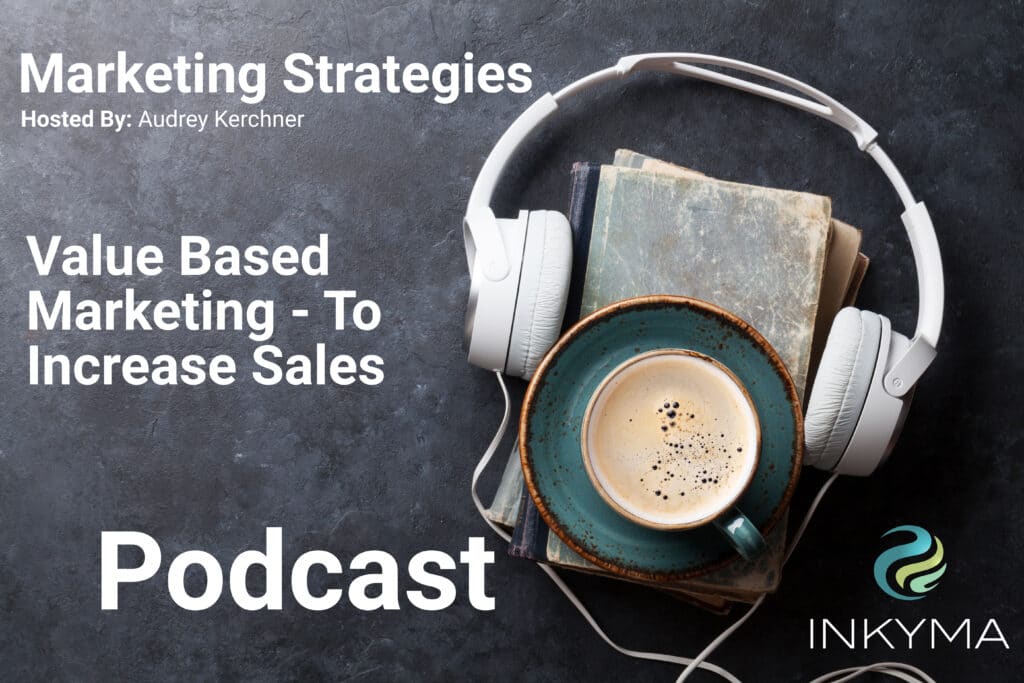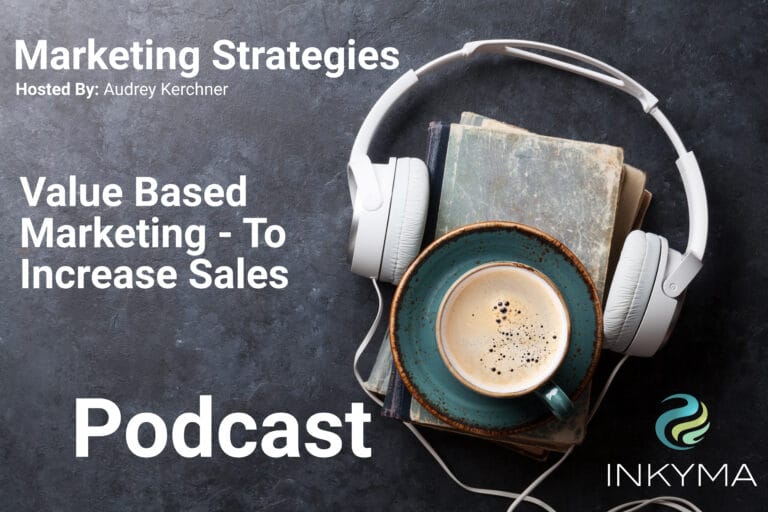
Marketing Strategies Podcast
Episode 7
Value Based Marketing To Increase Sales
Value Based Marketing is targeting customers who are willing to pay more for a product because it aligns with their values.
Learn how to be able to charge more and attract the right type of clients to your business. I share the top 3 core values and how to implement them.
Make sure you have listened to the Marketing Strategy Vs. Tactics episode 1st. You are going to need that basic information as well.
We also wrote an article that supports the podcast too. Check that out HERE
Check out our previous episodes on our podcast page.
The additional reading we suggest in the podcast Episode:



Value Based Marketing To Increase Sales Transcription
Introduction
Hi, this is Audrey Kerchner, co-founder and chief marketing strategist at Inkyma. Inkyma is a full-service marketing agency bringing that big agency process, feel, and service level to small business owners. We do marketing strategy, branding, website design and hosting, content marketing, search engine optimization, social media, and digital advertising. To learn more about what we do, ask us a question, or to schedule a marketing evaluation for your business, go to our website, inkyma.com. That’s I-N-K-Y-M-A.com.
If this is one of your first times listening to the show, we have quite a few under our belt. I strongly suggest that you go back and listen to the previous episodes. We talk about marketing strategy, we talk about branding, we talk about website design, we talk about hosting. We’ve got quite a few. And then as we go through shows, I’m actually going to reference some of those episodes so that you can go back and listen to them and use that information as it pertains to the episode I’m talking about.
So there are many ways to listen to all of the previous episodes. We have them on the website, and we are also on Podbean, Spotify, and Google Podcast, and Apple Podcast. We’re looking to bring more ways to let you listen to the content as we get more and more into episodes.
What Is Value Based Marketing?
So this week on the show, the topic I’m going to give you some information on and to share with you is value based marketing. The context around value based marketing is the ability to charge what you’re worth and to attract the right type of clients for your business. The reason I break this down and I talk about it a lot with business owners is what I hear from them is that they’re not the cheapest, they’re not the most cost-effective, and they’re afraid that they’re not going to get clients because of it.
What is value based marketing?
The ability to charge what you’re worth and to attract the right type of clients for your business. Read the article and listen to the podcast to learn more about how to implement.
And the way I start that conversation with them is you don’t want just anybody as a client, you want the right client for your business. As I like to say, if you market to everyone, you’re really marketing to no one. You don’t just throw everything out there and just take whoever comes to you. As you get along in business, and I’m sure as many of you veteran business owners know, is that not every client is the best client for your company. So value based marketing is really selling to consumers and other business owners, if you’re B2B, this works exactly the same way, who value quality and service over low price. It’s called value-based customers, right? That’s what they’re looking for, is value.
If you really hone it down, it’s actually a niche market. So for many business owners, they have a niche. They work with automotive companies, or they work with a certain type of consumer, and that’s who their best customer is. This is a niche just like those niches. So you can actually build your entire business around selling services and products to people who value companies that they charge more, but they get more around it. And so, you may be saying, “Well, what about those bargain shoppers?” I would say, “Let them weed themselves out.” You’re going to create language and you’re going to put things together where they’re going to look at it and go, “No, I don’t think this is for me.” And that’s really okay because then you’re not wasting advertising dollars. You’re not wasting your own time or your employees’ times trying to convince them to purchase your product or service when they’re really never going to do it anyway. It’s just not in their mindset. So let them go find something that works better for them.
Concept of Value Based Marketing
And so you got to start speaking the value based marketing language in order to attract and then not attract the right customers. So within that concept, there are actually three core values that you can market to, and I’m going to walk you through what they are, give you examples of them. But before we do that, I really recommend that if you haven’t listened to our very first episode, Marketing Strategy Versus Tactic, go back and listen to that. What that does is it’s going to help you outline what your goals are, help you figure out who your perfect customer is, create your customer persona, and figure out the language to use to market to them. And that information is really going to make this whole process easier to implement. This is like a stepping stone from that. You really need to have that strategy piece and your language and your audience locked down in order to really execute against these values.
Value Based Marketing – Emotional Value
So let’s get into the concept of value-based marketing and review the top 3 values. The first one is emotional value. What emotional value is is how your product or service makes that person feel or how they want to feel, right? We all want to feel something throughout the day, whatever is going on. That’s really the way emotional value marketing works. And so examples of the feelings that you may convey with most products or services are it’s less stressful, you have a happier life, you have security, you have comfort, you have safety, you have relaxation. And a big one is time, especially in value-based marketing. Time is usually one of the top three things that your product service can offer that people will pay more for it for.
So let me give you an example. Let’s say there is a CEO of a mid-sized company, and they’re working 60, 70, 80 hours per week. What they really want are products and services that give them some of their time back, time to be able to relax, time to spend with the family, or it makes the time that they’re spending with their family or what they’re doing, even if it’s a hobby, that more enriching to their lives. They will pay more if you can provide that to them. So that’s more service-based, but product-based is mattresses. I think the mattress industry does a really good job with this because when you look at mattresses by themselves, they’re a little boring, right? Big square boxes that we sleep on, they’re very utilitarian, but they range in price. You can get something as cheap as four or $500 or less, all the way up to thousands of dollars, right? Because sleep is important.
And so, what they market on is that emotional value of all the benefits of sleep. You’re happier. You’re more focused. Life is better when you’ve had a good night’s sleep. We all have felt that. And so they’re saying that a specific mattress designed for you or someone in your family can help achieve that. And that’s all emotional-based, right? “Buy this mattress so that you have a happier life, you have a happier child, you have a happier spouse. They’re more focused, they’re achieving their goals.” So start thinking about ways that your product or service meet those emotional needs of your consumer and create value based content marketing campaigns around this concept. And then even drill down further on who that consumer is. You can have specific targeted campaigns to parents of children about a mattress that helps them sleep better, get better test scores, and they do better in school. That’s a valid campaign, but you would be speaking to those same people differently if it was for their own mattress, right? So really think about that. You can get very granular with these.
Value Based Marketing – Social Value
The second value is social value. What social value is, is it’s how the customer is perceived by others in their circle of influence. So let’s say you have a consumer and they have invested in your product or service, how do other people see them, or how do they want other people to see them after they’ve purchased your product or service? I use the term investment on purpose. Folks that are value-based look at their purchases as not just, “I bought this.” It’s an investment, and they get a return on that investment. The values that you’re giving them are part of that return, which in turn allow you to charge more.
You’re not just charging for your base product or service, you’re charging for the whole package. And that whole package has a return on investment. So start thinking of your product or service in that way: what return on investment does my consumer, does my client, does my patient get by choosing me versus someone else? So this how other people think of me as a consumer is that concept of keeping up with the Joneses, right? Most of these clients that are value based marketing have the discretionary income to say, “Yes, I’m going to spend more on something because I value it more,” which means that they are in a circle of influence with people that are like them. And then everybody just wants to keep up with the others because nobody ever wants to miss out. They call it the fear of missing out, right? The Joneses don’t want to miss out on what the Smiths are getting because we all want this idealic life. We can call them status symbols too.
But in their mind, they’ve worked hard to achieve what they have, and they feel like they deserve these things, and they want them to have them for their family too. So part of that status is respect and admiration. And then the other part of it is these are their friends, their families, their colleagues, again, that circle of influence. They want to share, right? If they bought what you sell and they had an amazing experience, they have the great service, the emotional value is associated to it, they want to share it with others. They want others to feel the joy that they have. And so, that’s actually part of the social value too. “Hey, I just signed up for this great service, X, Y, Z happened. I think you would like it too.” That is part of their social value, that giving to others what they’ve already learned and received.
And then in turn, what this does for you is it turns them into a brand ambassador because part of a value-based purchase is you do your research. You read the materials, you educate yourself, and then you share that. And if they’re using the language that you’ve created to sell your product or service, they’re actually becoming a brand ambassador for you. So product examples, and we’re going to go really high here, is Apple and Fitbit with their smartwatches. Those have actually become status symbols because they’re health-related, and they make our lives a little easier by having more things on our wrist. And they’re large watches. Before they had come out, large watches weren’t a thing. But now because of the status and the influence that the people buying them have, now when you see someone with one of those, you’re like, “Oh, okay.” You derive certain ideals about a person when you see that.
Now on the service side, what I think a really good example of this social value is, is any home mobile service. So I’m talking dog grooming, house cleaning, massage therapists, personal trainers, hairstylists, salons, even the medical industry, having a service that you would typically go out for brought to your home and the service done there. I think this is probably one of the most up-and-coming categories of services, and these are highly value-based services. So let’s go back to that CEO who’s working 60, 70 hours a week, or maybe there is a business owner who works from their home. They have a family. They have small children. They’re doing all of these things. They are absolutely going to be willing to pay more for that home service to have the dog groomed at their home because then they don’t have to factor in time into their schedule to travel somewhere, to wait their turn, and then travel back home. Who’s going to watch the kids? Who’s going to do this? Versus they get to work right up until the moment that you’re there, and then there’s supervision because there’s people in the house.
As a business owner, the reason why I think this is such an up-and-coming market is that you’re spending less money on rent and facility and equipment and by people having come to you versus being mobile and you get to charge more by going to them than if they were coming to you. And again, there’s that social piece associated to it. “This is great. We get the dog groomed every week now because they come to the house, I bring the dog out to the truck that sits in the driveway. And when they’re done, the dog gets to come back in the house. The dog is relaxed because they’re not sitting in a facility in a cage waiting for me to come pick them up. I love it so much.” Again, that’s part of the social value, is their experience with the service
Value Based Marketing – Philosophical Value
So now the third and final value, which is probably the most complicated out of all of the three of them to explain or to grasp, is philosophical value. What philosophical value is it’s the customer is investing in your product or service because they are in line with your value of trying to make the world a better place, or helping to make the world a better place. They believe in your cause, and they believe in what you are trying to do. And they believe in your philosophy. A company that does this, and I think I’ve talked about them before, is Toms. For every pair of shoes you buy, they donate a pair of shoes to people who need them. So they’re giving back to the community. I would say a philosophical value, giving-back campaigns are probably the easiest to understand, but there’s other ones, and there’s different nuances to this.
Another example is that a company may support a specific community. They may support a non-for-profit, or they may sit on a foundation board that aligns with their business and their business category. So let’s go back to the example of the dog grooming business, the mobile dog grooming business. Their philosophical value around dogs is that they care about dogs, right? They do this because they want to give dogs their best experience. So then what they do is maybe they give a portion of the proceeds back to local shelters, or they require all of their employees to donate a certain amount of their time every month to work at these shelters or to work at some type of pet-specific event. So that way, a consumer can say, “Not only am I getting values that I need from this service, but I’m also helping others.” And helping others is such a powerful message because all of us want to help in some way, shape, or form. Some of us can do more. Some of us can do less. But when we’re asked to help and we can help, we gladly help. And we have a sense of self-worth. By you creating these giving-back campaigns or injecting that into your business, you’re actually giving your customers a way to give back that is easy for them while still getting the services that they need.
Another example is supporting the environment, and the home industry does this, right? They call it the home shelter industry. So this is your contractors, your architects, your interior designers, anybody in that field. A lot of them have the need to make sure that what they’re creating is helping to support and sustain the environment. It could be through product, it could be the way something is designed. So if you are a consumer and you’re like, “I want to build a home, but I want it to be an environmentally-friendly home. I’m going to find an architect and a contractor that believes in this as much as I do. I want to support them because they’re supporting my value.” So it’s really a give and take type of value system with philosophical values. And then so much so that architects and contractors, and even interior designers, can get certified in green building so that they’re educated and they know exactly how to do this.
And then you have your giving-back campaigns as well, not only for our product-based companies but for service speaks companies, so where the company may put aside a certain amount of money and then give that back to the community directly in something that is very close to why they run their business. Here’s an example. There’s a local auto repair company called Adam & Sons. We’re actually going to be bringing them on the show in a couple of weeks. What they do is they have a stranded motorist fund. They’ve created this fund themselves, and they put money into it so that if someone who needs to have a repair on their car done so that their car stays running so they can go to work, but they can’t afford it, they can apply for that grant. Or if their car breaks down on the side of the road, they can get free roadside assistance to get them to Adam & Sons so that then they can get the repairs they need to keep them on the road, which I think is an amazing program. And it’s something that they created themselves so that they could give back to the community that has supported them all of these years.
Many companies out there do something like this, but they may not think of it as a way to enhance their business, enhance their brand, or to market to it. But I think it’s a missed opportunity if you don’t market to these things. If you’re going to take the time to create it, then you should take the time to make the community aware of it and let them make a decision. “Yes, I think that’s great. I want to support that company because they’re doing these things, and my values align with their values.” Now more than ever, especially millennials and Gen Z, it’s been in their mind from the beginning. “I want to support companies that make me feel good.” But now because of that popularity, even the rest of us older folks, the Gen Xers, the boomers, everybody, we’re all like, “You know what? That’s not a bad idea. Let’s support companies that align with our values so that we can feel good about our purchases.”
So I think it’s something that regardless of the generation, we’re all aware of it, and then we’re all looking for it. It may be that one thing that tips that decision, it’s because of that last factor. So think about including this in your branding and in your marketing. Not just at the company level, but you can do it at a product-specific level too. If you have certain products that really highlight that more, and especially if they’re your best sellers or your best lucrative products, definitely incorporate this in.
A company that I think does this really well from a marketing perspective is Infinite Disposal. We’ve had them on the show, so go back and listen to that episode where we interview Chad. They’re committed to protecting the environment. And so you probably wouldn’t think, “Oh, a garbage company or a trash company is a trash company.” But they’re really committed to what they do. They’re doing this, and they’re doing it the right way. They’re heading up and looking into the future at industry standards, and they’re adopting and incorporating them before the government requires them to do so. They’re doing the right thing because it’s the thing that makes sense. And they know that recycling is important. You see it on their marketing materials, you see it on their website. They’re stewards of the environment, and that’s how they see themselves, which I think is just really fantastic.
And so part of all of that messaging, I want you to invite your customers to help you achieve the goal that you’re giving back or your environmental support. Or any type of campaign that you’re doing, ask them to help. I think that asking to help is a very powerful message because when we’re asked to help, like I said before, if we can, we say yes, and by making a specific purchase, that’s a way for them to say yes. And it’s very, very simple. So don’t think that you’re diminishing or minimizing your program by asking your customers to help. If anything, you’re just able to help more people if you’re making more sales.
Valued Based Marketing – Take Action
So those are the three values. Now we’ve got to talk about implementation. How do you take this in? Where do you put it in? What do you do with it? So you have to, one, figure out what that new messaging looks like. And then now let’s talk about where to put this. So you’re going to put it on your website, in your website copy, hero image, homepage, that’s where you want to put the majority of your emotional value messaging, right? When they first come to your site, they need to understand that you’re trying to align yourself with whatever their emotional needs and values are. And then the next place to make sure you put that is in your product and service description. And what this does is it helps them to justify the price and to justify the purchase because you’re educating them on, “You’re not just buying this product or service, you’re also getting all of these values associated to it.”
Sales funnels are an amazing way to take them on the journey and to talk about all the different values that you provide, not just the product or service. Because you get to do it over six or seven emails with calls to actions, and then it’s done over a series of days. Blog posts are great as well. If we go back to the mattress company example, you can do a blog post and educate them on cooling materials if they’re hot sleepers. Right there, just the creation of the article provides value. You took the time to educate them so that they understand what type of materials they need in order to sleep cooler and sleep better and be happier so that they wake up focused. Newsletters are great too. You can sprinkle that in there as well. Ads are great. I like using this type of language in ads, mainly because it actually makes your ad spend cheaper. Because if someone’s reading it and, let’s say, they’re a cost-based person, right, they’re looking for the cheapest solution, they’re going to read your value-based ad and probably pass on it versus click through and then saving you the time, energy, money, and expense of having to deal with them in your pipeline.
Social posts. I think social posts are a really great way to do this, and it actually improves your ability to sprinkle in more calls to action without making them feel like calls to actions. Social posts, we like to follow a three to one ratio; three educational posts to one call to action, right? Let’s educate them and earn the right to ask for the business. But those educational posts, if they are value-based, where you’re talking to them about their benefits and not the product benefits, is you’re really actually still selling them during that process. And then any of your leave-behind materials. So look at your business cards, look at any brochures, look at any catalogs. Or if you have a look book. If you are a construction person or a construction company, and you’re showing before and afters, figure out how you can get that value-based messaging into that book while they’re perusing things or your product catalogs.
So once you’ve figured out that language, and now you have ideas of where you can put this, the other thing I also want you to do is find images and videos that support the values that you’ve outlined as well. Imagery, people get a message so much faster by viewing it and reading it. And then videos are worth their weight in gold because viewers retain 95% of a message when they watch it compared to 10% when they read it. So if you’re going to take the time to write something, take the time to create a video, because then the two together, the retention just skyrockets. An example here is if you’re a contractor and you’re doing kitchen remodels, and your value is that you’re catering to people who want to have a beautiful, functional kitchen where they can entertain, they can cook for the family. And then you add a video of a happy family cooking together in a beautiful kitchen. As people are watching that, they’re going to put themselves in that person’s shoes. “I want that. I want the happy family. I want the quality time with the kids while they’re not on screens, while they’re talking to me, while I’m helping them learn a life skill of cooking.”
That is far more impactful than a paragraph that someone may or may not read. We are hardwired to watch something that’s put in front of us and played because we’re trying to figure out whether or not it’s going to eat us, right? It’s that whole motion thing. And so we start watching the video and then it grabs our attention and we finish it versus a paragraph is static on a page and we make a decision, do I have time to read this now or not?
So the final thing I’m going to leave you with here is I want you to do this ethically. We all want to charge as much as possible for our product and service, but I don’t want you to implement something like value-based marketing just so that you can charge more. You need to believe in it, and you need to believe that you’re worth it. So if you do have emotional, social, and philosophical values that you need to pull in to justify the purchase, that’s exactly what I want you to do. But I don’t want you to just go raise rates and then try to find excuses as to why you’ve raised those rates. Because it’s just never going to come through. You’ve got to market authentically.
So now is the time I want you to take action on Value-Based Marketing Strategy. Make sure you’ve decided what your products and services are really worth. Pick one of the three values to start with implementing. Don’t try to tackle all three. And then update and enhance your marketing strategy. Then I want you to create the messaging to support that value. What is the return on the investment for your potential clients? And then find images and video to support the message so that you get the fastest retention of that message possible. So this isn’t simple, right? This is a little more advanced, and it’s challenging, especially if you’re split between wanting to charge what you’re worth, feel good about what you’re doing, and then make money to sustain yourself, your company, your business, and then your employees but not feel like you’re taking advantage of the customer. And so if you feel like you’re split, or if this is really challenging for you, then consider hiring an agency to do it for you.
They will talk to you. They will figure out what your values are as part of the conversation. You can even talk to them about pricing increases. Sometimes it’s easier if someone just says, “Yeah, this is exactly what I think you’re worth.” Then they will go through recreate all the language, implement it where you need it implemented, and then create images and video to support it. So here at Inkyma, we like to give back to our business community. I provide a free 45-minute marketing consultation to any business owner. Maybe you want to talk about value-based marketing and figure out if you can implement it yourself, or maybe you want to talk about how we can implement it on your behalf, either way is great. That 45 minutes is for you to do whatever you need to do to get your marketing forward with your business.
So just go to our website, Inkyma.com, I-N-K-Y-M-A.com, and click on the Schedule a Marketing Evaluation button in the upper right-hand corner. Pick a time, and then you are just on my calendar. But if all you have is just a question or about something else that you’ve listened to, put it in the contact form, we’ll definitely answer it. And then as we read through them, we like to bring them onto the show and then answer them here too. But we respond to all of them regardless of which way we get them. So that is it for this week, and I hope you have an amazing day.
Thanks for listening to Marketing Strategies Value Based Marketing with Audrey Kerchner, sponsored by Inkyma. From strategy to execution, Inkyma can create effective marketing plans designed to grow your business with branding, website design, content marketing, and digital advertising. That’s Inkyma, I-N-K-Y-M-A.com. And be sure to listen to the companion podcast on Podbean anytime.



We are now on Amazon Music and Audible












